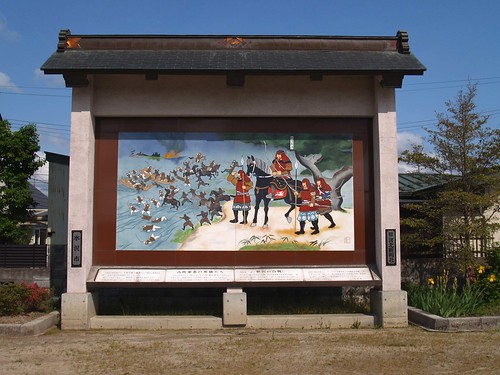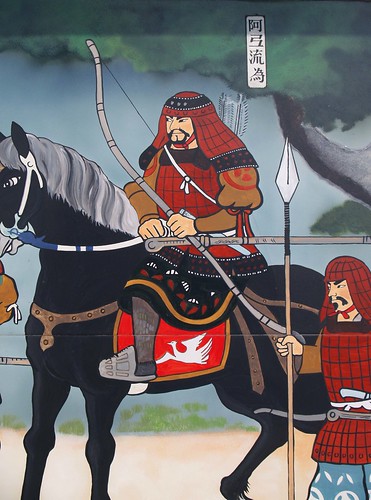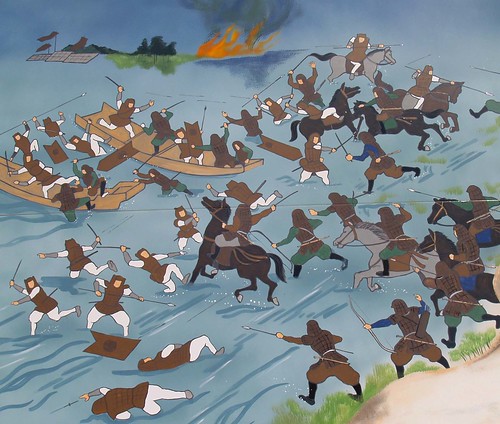The Battle of Sufuse Village

[The Battle of Sufuse Village in a park in Mizusawa]
North America has it's "Wild West" full of high drama, adventure, violence, gold and larger-than-life heroes. These included cowboys, outlaws, explorers, priests, soldiers and Indians, to name just a few. We learned about them from our earliest childhood as they alternately committed crimes and righted wrongs over and over again on the big screen and in paperback novels. In much the same way Japan had its own "Wild West" about 1,000 years earlier than North America!
Northeast Japan, or Tohoku, was inhabited by a group of people called the Ezo or Emishi. They may or may not have been related to the peoples who came before, the Jomon, or the ones that came after, the Ainu and the Yamato. (The Yamato were the people we now call the Japanese.) These Emishi led what might be called a fairly simple life of hunting, gathering and farming. They lived in small villages which in turn made up larger groups like the tribes or nations found in North America. Two of the strongest groups were in the area that is now Iwate; the Shiwa and the Isawa.
The Isawa Emishi seem to have dwelt along the Kitakami River in an area from the Koromo River in the South to perhaps the Waga River in the North; roughly the area encompassed by present day Oshu City and Kanegasaki Town. What is now Mizusawa Ward of Oshu City was then the heart of Isawa territory and this is where it's greatest leader and hero, Aterui, lived. Unfortunate;y we can only know about him from his enemy, the Yamato, as the Emishi themselves left no written records!

[Aterui on horseback]
The 8th century saw numerous Yamato expeditions against the Emishi which all ended in defeat and humiliation for the Emperor. In 776 two separate attacks were launched against the Isawa and Shiwa Emishi. The first, in February, employed 20,000 troops in a surprise attack over the Ou Mountains that was neither. It was not a surprise and the heavy Yamato infantry couldn't catch the quick moving Emishi cavalry to attack them! They finally went home in May having accomplished nothing.
Ten years later, in 786, a certain Ki no Asami Kosami was appointed the new General of Eastern Conquest. He already held several important positions in the government including Councilor of the Cabinet, Secretary of the East Palace and Middle General of the Interior Guard. Unfortunately none of these seem to have prepared him much for a long military campaign in the field against a determined foe! Nevertheless he led a force of some 52,800 persons out of Fort Taga, near present day Sendai in Miyagi Prefecture, in the Spring of 789.
This force crossed the Koromo River into Isawa territory on March 28th and made their camp in the plains where the Koromo meets the Kitakami. There they rested for some three months before finally launching an attack in June. The Yamato army consisted of some 4,000 soldiers in three armies. The Center and Rear armies crossed the Kitakami while the Front Army remained on the West side of the river. Then they headed North on each side of the Kitakami burning crops and villages as they went. Their plan was to meet up at Sufuse Village where the Front Army would cross the Kitakami, join the other two armies and attack the Isawa Emishi.
A group of about 300 Emishi attacked the Front Army as the proceeded North but were easily repulsed. They were, however, strong enough to prevent the Front Army from crossing the Kitakami. The Center and Rear armies were attacked by about 800 Emishi in the front and stopped their advance. As they were falling back another Emishi force of 400 troops arrived from Higashiyama attacking their rear. The Emishi killed five of seven commanders and 25 soldiers with their arrows and wounded another 245. The Yamato armies on the East side of the Kitakami were pushed into the river by the superior firepower of the Emishi who swept down from the hills on horseback. In the river another 1,036 soldiers drowned while another 1,257 lost their armor according to General Ki no Asami Kosami's report. The Emishi were reported to have lost 89 dead, but 14 villages and about 800 houses were burned along with crops and farm machinery.

[The Emishi driving the Yamato into the Kitakami River]
On September 8th General Ki returned to the capital where he was rebuked by the emperor. It seems that the general and his four vice generals had not led their troops into battle! They had remained in camp and entrusted the entire operation to their commanders! Aterui had won the battle but he was not strong enough to follow up this victory by attacking the Yamato in their own territory. He himself surrendered to the Imperial forces a few years later allowing the Emperor to build a line of forts up the Kitakami Valley and posses it as his own land. This was the last full scale battle between the Emishi and the Yamato.
Much of this account comes from the excelent material on Suzutayu's wonderful web site the Conquest of Emishi. I highly recommend it for further study. There is another useful site about Aterui on the Unveiling Histories of the Tohoku District web site by Eishiro Ito.

1 Comments:
Hey there!
Lovely commentary! I learned a lot. Thanks for linking to this from Flickr! :3
Post a Comment
<< Home